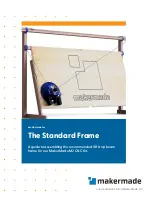
Fig 4
Caution:
The machine is heavy!
382kg
Assure the sufficient load capacity
and proper condition of your lifting
devices.
Never step underneath suspended
loads.
Carefully place the machine to the
floor.
Use 4 anchor bolts of sufficient size
and length.
Use a machinist’s precision level to
make sure that the machine table is
level.
Loosen mounting bolts, shim and
tighten mounting bolts if needed.
The machine must be level to be
accurate.
5.3 Mains connection
Mains connection and any extension
cords used must comply with
applicable regulations.
The mains voltage must comply with
the information on the machine licence
plate.
The mains connection must have a
10 A surge-proof fuse.
Only use power cords marked H07RN-
F
Connections and repairs to the
electrical equipment may only be
carried out by qualified electricians.
ATTENTION:
- If the direction of rotation is not
correct, the phase converter inside the
CCE Euro plug must be pushed in and
turned 180°.
5.4 Initial lubrication
The machine must be serviced at all
lubrication points before it is placed
into service!
Failure to comply may cause serious
damage.
(see chapter 8 for lubrication)
The coolant tank has to be filled with
coolant.
5.4 Starting operation
Before starting the machine check
the proper chucking.
You can start the machine with the
green ON-button (X, Fig 5).
The red OFF-button (R) stops the
machine.
Fig 5
The emergency stop button (Y) stops
all machine functions.
Attention:
The machine still has electric power!
Turn emergency stop button clockwise
to reset.
Use the variable speed select knob (V)
to set the speed.
The digital readout (U) shows the
spindle speed.
6. Machine operation
Always adjust the table and the depth
stop to prevent drilling into the table or
vise.
Secure workpiece to the table with
clamps or a vice to prevent rotating
with the drill bit.
T-slot size is 16mm.
Feed the bit into the material with only
enough force to allow the drill bit to
work.
Feeding too slowly may cause burning
of the workpiece.
Feeding too quickly may cause the
motor to stop and/or the drill bit to
break.
Recommended speeds for a 10mm
HSS drill:
Wood:
2000 RPM
Plastic:
1500 RPM
Aluminium:
1500 RPM
Brass:
1500 RPM
Cast iron:
1000 RPM
Mild steel:
800 RPM
High carbon steel:
600 RPM
Stainless steel:
300 RPM
Generally speaking, the smaller in
relation the drill bit, the greater the
RPM required.
Wood requires higher speeds than
metal.
Metal is usually drilled at slower
speeds; cutting oil is applied if
necessary.
Warning:
Always keep your hands well clear of
the rotating bit.
Never place your fingers in a position
where they could contact any rotating
tool, chuck or cutting chips.
Do not remove chips and workpiece
parts until the machine is at a
standstill.
Always close the chuck guard and
pulley cover before you start the
machine.
When using a drill press vice, always
fasten it to the table.
Never do any works
“freehand” (hand-
holding the work piece rather than
supporting it on the table), except
when polishing.
Support long workpieces with helping
roller stands.
Do not use wire wheels, router bits,
shaper cutters, circle cutters, or rotary
planers on this drill press.


























